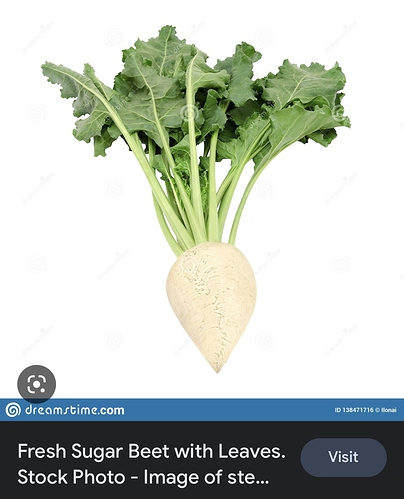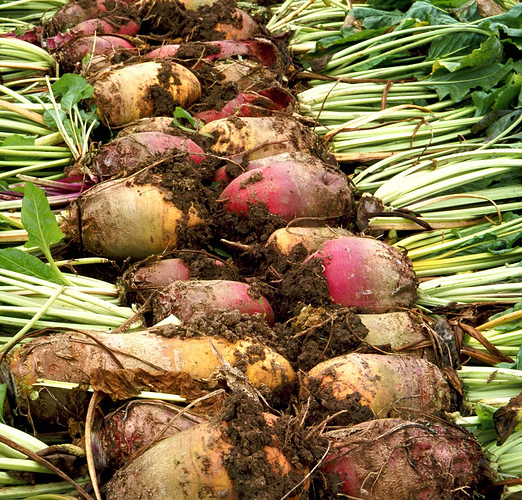Do you have access to an Apple cell phone? If so, take a photo, open up the small picture at the bottom left, then hit the “i” button; it’s circled. After that, push, plant look-up. It’s fantastic! I have tons of plants, shrubs, etc. and it works great! It told me I have some plants that I’ve never heard of. It’s fairly accurate!
OMG what a cool tip! I don’t think what I got is narrow enough in this case (field mustard) but I will definitely use this again, thanks! Had no idea.
I’ve decided it’s probably sugar beet. This photo is a prettier version of what I have, and the closest match I’ve seen:
I’ve found tiny crab claws in my pasture before and the closest river is 3.5 miles away, so this would be far from the strangest thing birds dropped here! We also had perk testing done this spring so the seeds could have been tracked in by the digging equipment or on someone’s tires.
The tiny crab claws are probably from residents right in the field, not imports. We have tiny lobster looking crustaceans that live in the dirt of our fields. We call them crayfish, about 2-3 inches long. I have found the entire exoskeletion which i presume they shed lIke crabs do, to grow bigger. . They come out when we get lots of water, usually spring and fall. They make interesting looking stacks of dribbled dirt at the entrance to their burrows. Probably keeping the entrance cleared out. Son got curious about them as a kid, dug one up. Burrow was about 3ft down, had lots of piled up dirt! Did catch the little creature to look ar, then filled in the CRATER he dug and turned it loose again.
Try smelling burnt rutabagas. 


Mom did that more than once, pealed, put them on to boil, then went and fell asleep.
Not one of my favorites.
On the plus side, she always mixes in at least a half a pound of cooked bacon in hers. A pound of bacon was cooked, but a good bit of that was eaten before being sullied with rutabagas.
Hers are always that bright orange. Dad went to Thanksgiving with her family before they were married…thought they were mashed sweet potatoes. It was apparently a rather shocking experience for him…besides meeting her rather colorful family.
Pass on the burnt 'bagas 
But adding bacon is a Really Good Idea 


That is an excellent point. I occasionally loan my tractor to help others with manure managment and mowing when someone’s tractor is in the shop.The extension agent has cautioned me to pressure wash the tractor thoroughly when it is returned to minimize weed seeds being transferred to my pastures. Sandspurs are particular problem weeds that are prevalent around me…
This is just an interesting thread for me; so even though the answer probably doesn’t really matter…the photo you’ve posted is a stock photo which is used for a variety of different beets. It doesn’t really look like sugar beets if you actually search through sites that sell beet varieties. But, that said, who knew there were so many types?
It’s likely either sugar beet or fodder beet that has been planted for the purpose of feeding livestock or deer. I think if the OP lived in an area where commercial sugar beets were planted in the vicinity she would recognize them much like we recognize common crops; like soybeans in my area, which are typically planted for soil replenishment.
Here are a couple of seed sites that show different varieties of fodder and sugar beets:
I don’t know anyone that plants them for livestock, but do know people who plant them for deer.
[quote=“S1969, post:28, topic:778450, full:true”]the photo you’ve posted is a stock photo which is used for a variety of different beets. It doesn’t really look like sugar beets if you actually search through sites that sell beet varieties.
[/quote]
Argh, darn it, I hate that Google Image search got me! I’m usually more alert to inaccurate search results. But yeah there seem to be a lot that look very similar and once I decided not to eat it I didn’t spend much time looking. It was more a curiosity than anything else! I still think it’s some type of beet? I’ve never seen a field of them around here and I don’t like beets, so I’m not that familiar. Mostly we have soybeans, corn, sorghum, winter wheat, rye, etc.
Actually I was referring to Equibrit’s photo, but yours also could be a stock photo. It’s so hard to know anyway because the ones in the photo look so clean! 
I agree it’s some kind of beet/turnip/mangel. The only reason I know about fodder beets is a) from a book I read that was set in Germany or Austria and the kids ate the mangelwurzel even though they were for the cows; and b) my brother has planted mangels as a deer plot.
So…not exactly experienced in beet crops other than my own garden.  I’ve never seen a field of them either.
I’ve never seen a field of them either.
The first link, second row, showing brown, gnarly beets is the kind of sugar beets I am used to seeing. Photo is deceptive in the size, the beets actually are each in the 15 to 25+ pound size. Sugar beets are a big crop in mid-Michigan where the sugar processing facilities are located. The conveyor in the picture is HUGE, to make piles of beets 2-3 stories high, and very wide. The storage areas are acres of pavement. Dump trucks and loaders moving the beets look like Matchbook cars next to the piles! It will take most of winter to get all the beets processed into sugar and other products, IF the weather stays cold to prevent rotting. Everything is stored out in the open, no covering the last time I went by there.
I was pretty amazed at this product when I started working in that area. Seeing the beet trucks heading to the facility to dump beets. Regular convoys of loaded trucks. Also seeing the occasional large beets along the road, despite covers over the loads. NO ONE tailgates those trucks!
I read my sugar sack labels to make sure I am buying Michigan beet sugar to support our farmers.
I do come from an area where they are planted routinely in the summer, (followed by winter wheat), to be processed in to …SUGAR !


